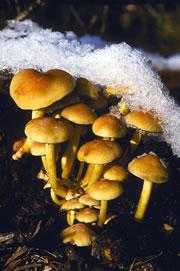 Sulphur tuft has started to fruit twice a year, even before the snow melts.Science
Sulphur tuft has started to fruit twice a year, even before the snow melts.ScienceClimate change could turn the autumnal fungus foray in Britain into a year-round event, say researchers who have recorded changes in fruiting patterns over the past half-century.
In the autumn, the UK mushroom season has doubled in length, from about 33 days in the 1950s, to nearly 75 days now, they say. Fungi are starting to fruit earlier, and finishing later.
And some species are fruiting in both spring and autumn — a unique development in response to rising temperatures, says Alan Gange of Royal Holloway, University of London. Although it has been shown that climate change is making birds nest and flowers bloom earlier, he knows of nothing else that has added a complete extra breeding season to its life cycle.
Gange's father, Edward, is the 'fungal recorder' for the Wiltshire Archaeological and Natural History Society. From 1950-2005, he collected data on when, where and what fungi grew around Salisbury, a city in south-west England, keeping the records on index cards.
When he retired from his day job as a stonemason, he bought a computer and digitized the data. "He typed 52,000 records into Excel," says Alan Gange.
Of the 300 common species of British fungus analysed, more than 70% show a significant change in their calendars. The species showing a spring fruiting include sulphur tuft (Hypholoma fasciculare), honey fungus (Armillaria mellea), which can kill trees in gardens and orchards, and the fairy-ring mushroom (Marasmius oreades).
Mushroom hunters trying to identify their haul should disregard the fruiting dates given in field guides, says Gange: "You can expect to find fungi fruiting in any month of the year."
Changes in fungal fruiting dates haven't gone un-noticed by mushroom pickers, says naturalist Andy Overall, a self-taught expert who runs London's 'fungi to be with' club. "When I started in 1992, you'd get to November and everything would go dead," he says. "That hasn't happened for five or six years — now fruiting goes on into December."
Warm bursts aplenty
Fungi spend most of their year out of sight, as (sometimes vast) networks of underground fungal filaments. But following a certain quantity of warm weather, and a burst of rain, they throw up spore-bearing mushrooms. Frosts bring the season to a close.
The extended autumn season is due to warmer summers, wetter autumns, and fewer autumn frosts — although very dry summers can also delay mushroom fruiting, says Overall.
The extra spring season is probably a consequence of warmer weather in late winter and early spring, Gange thinks. In that area, Gange notes, February has warmed more than any other month, from an average temperature of 3.5 °C in 1950 to 5.2 °C now.
ADVERTISEMENT
Flourishing fungi will have a knock-on effect throughout the ecosystem, with faster decomposition meaning more nutrients for plants. "Apart from the effect on pathogenic fungi, it's probably a good thing," says Gange. "I don't think there's any harm in improving tree growth."
Gange now plans to use his father's data to see whether mushrooms have also become more abundant over the past 50 years.
Visit our poppingup_yearround.html">newsblog to read and post comments about this story.
